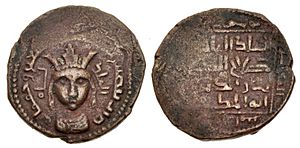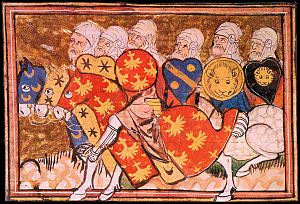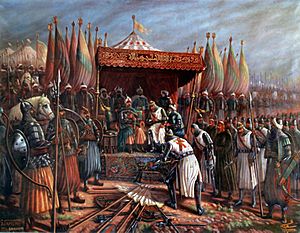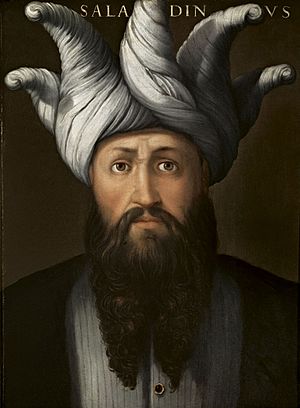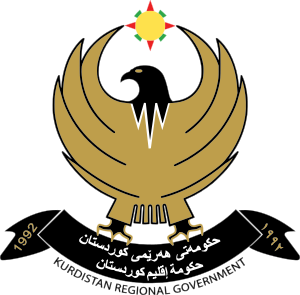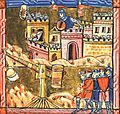Saladin facts for kids
Quick facts for kids Saladin |
|||||
|---|---|---|---|---|---|
|
|||||
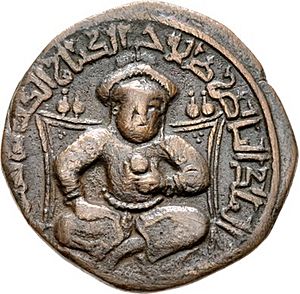
Dirham coin depicting Saladin (c. 1189)
|
|||||
| Sultan of Egypt and Syria | |||||
| Reign | 1174 – 4 March 1193 | ||||
| Coronation | 1174, Cairo | ||||
| Predecessor | Al-Adid (as Fatimid caliph) | ||||
| Successor |
|
||||
| Born | c. 1137 Tikrit, Upper Mesopotamia, Abbasid Caliphate |
||||
| Died | 4 March 1193 (aged 55–56) Damascus, Syria, Ayyubid Sultanate |
||||
| Burial | Umayyad Mosque, Damascus | ||||
| Spouse | Ismat ad-Din Khatun | ||||
| Issue |
|
||||
|
|||||
| Dynasty | Ayyubid (founder) | ||||
| Father | Ayyub ibn Shadi | ||||
| Religion | Sunni Islam | ||||
Saladin, also known as Ṣalāḥ ad-Dīn Yūsuf ibn Ayyūb, was a famous Muslim leader. He lived from about 1137 to 1193. He was a Sultan who led the Muslim world during the Crusades. The Crusades were a series of wars between Christian Europe and the Islamic Near East. These wars were fought over control of holy lands, especially in what is now Palestine.
Saladin was of Kurdish origin. He became a powerful leader who united much of the Muslim world. His empire included Egypt, Syria, Mesopotamia, and parts of North Africa. Many Muslims see him as a hero because he successfully fought against the European Crusaders for over 20 years.
He founded the Ayyubid dynasty, a powerful family that ruled over many lands. The name "Salah ad-Din" is an honorary title. It means "The Righteousness of the Faith" in Arabic. Saladin is remembered for his military skills and his fair treatment of enemies.
Contents
Early Life and Rise to Power
Saladin was born in Tikrit, a city in what is now Iraq. His real name was Yusuf. "Salah ad-Din" was a special title given to him. His family was Kurdish and had moved from Armenia. They became part of the Arabic-speaking world.
Saladin's father, Ayyub, was a warden of a fortress. In 1132, he helped an army led by Zengi, a powerful leader. Zengi later repaid this kindness by making Ayyub a commander in Baalbek. Saladin grew up in Damascus, a city he loved. He was well-educated and especially interested in religious studies. He knew a lot about the Quran, the holy book of Islam. He also knew about Arab history and languages like Kurdish, Arabic, Turkish, and Persian.
Saladin's military career began under his uncle, Shirkuh. Shirkuh was a top military commander for Nur ad-Din, another important Muslim ruler. In 1164, Saladin, at age 26, joined his uncle on a trip to Egypt. They went to help Shawar, a high official in Egypt, who had been forced out of power.
Becoming a Leader in Egypt

Saladin played a key role in battles in Egypt. One important fight was the Battle of al-Babein in 1164. Saladin helped lead the army to victory. After this, Saladin was left to defend the city of Alexandria against a large Crusader army.
In 1169, Saladin became the vizier of Egypt. A vizier was a very high ruler, like a prime minister. He was chosen by the caliph, the religious and political leader. Saladin was a Sunni Muslim, while the caliph was Shia. Some thought Saladin was weak, but he quickly proved them wrong. He stopped a plot to kill him and put down a big revolt by soldiers in Cairo.
Saladin began to make his power stronger in Egypt. He gave important jobs to his family members. He also built new colleges for Sunni Islam in Cairo. In 1170, he led a campaign against the Crusaders. He captured the Crusader castle of Eilat on an island.
Sultan of Egypt
In 1171, Saladin was asked to bring back the Abbasid caliphate in Egypt. This meant replacing the Shia caliph with a Sunni one. The caliph, al-Adid, died soon after. On September 18, the Abbasid caliph was officially recognized in Egypt. This made Saladin the Sultan of Egypt.
Saladin then joined forces with Nur ad-Din to attack Crusader castles. However, Saladin had to return to Cairo because of problems there. In 1173, a Nubian army tried to attack Aswan, an Egyptian city. Saladin sent his brother, Turan-Shah, to help. The Nubians were driven away.
Saladin's father died in 1173. In 1174, Saladin sent Turan-Shah to conquer Yemen. This added Yemen and its important port of Aden to Saladin's growing empire.
Conquering Syria
In 1174, Nur ad-Din, Saladin's former teacher, died. His son, as-Salih, who was only eleven, took over. This left Saladin with more freedom to act. Saladin had a big decision to make. He could attack the Crusaders from Egypt. Or he could try to take control of Syria, which was in chaos after Nur ad-Din's death.
The people of Damascus asked Saladin for help against other rivals. Saladin quickly rode to Damascus with 700 horsemen. On November 23, he arrived in Damascus and was welcomed. Four days later, he took control of the Citadel of Damascus.
More Conquests in Syria
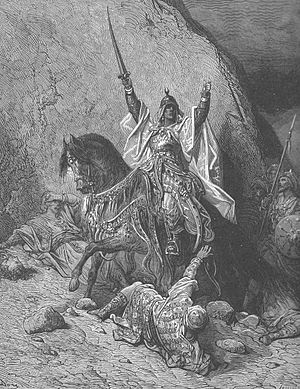
Saladin left his brother as governor of Damascus. He then went on to conquer other cities that had belonged to Nur ad-Din. He easily took Hamah. He then moved towards Aleppo, a strong city. The city's leader, Gumushtigin, refused to give up.
In 1175, a group of Assassins tried to kill Saladin in his camp. They were stopped before they could succeed. Saladin later took the city of Homs after a tough fight.
Saladin's success worried other Muslim leaders, especially Saif al-Din of Mosul. They saw Saladin as taking over their family's lands. Saif al-Din gathered a large army and marched against Saladin in Hama. Saladin's army was smaller, but he chose a good position. On April 13, 1175, Saladin's experienced soldiers crushed the enemy army. This was a big victory for Saladin.
After this win, Saladin declared himself king. He ordered prayers in his name in all mosques in Syria and Egypt. The caliph in Baghdad also recognized him as "Sultan of Egypt and Syria."
The fight for power continued. In 1176, Saladin again defeated Saif al-Din's forces near Aleppo. Saladin's army seized all the enemy's supplies. He then freed the captured soldiers and gave them gifts.
Saladin continued towards Aleppo. He captured the fortress of A'zaz. Another Assassin tried to kill him there, but Saladin was only slightly hurt. A'zaz fell on June 21. Saladin then made a truce and alliance with Aleppo. He allowed Gumushtigin and as-Salih to keep the city. In return, they recognized Saladin as the ruler of all the lands he had conquered.
Campaign Against the Assassins
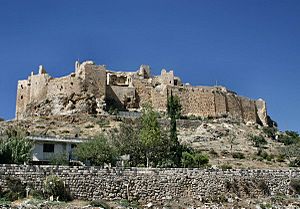
After making peace with his rivals and the Crusaders, Saladin faced a threat from the Assassins. This group was led by Rashid ad-Din Sinan. They had strong fortresses in the mountains. In August 1176, Saladin led his army into their territory. He destroyed the countryside but could not capture any of their forts.
Some historians say Saladin's uncle helped make a peace deal between Saladin and Sinan. Another story says Saladin found a warning note and a poisoned dagger in his tent. This made him leave the siege. In reality, Saladin wanted to make an alliance with the Assassins. This would stop them from helping the Crusaders against him. Saladin and Sinan later worked together to fight the Crusaders.
Return to Cairo and Battles in Palestine

After his campaigns in Syria, Saladin returned to Cairo in September 1176. He had been away for two years. He focused on strengthening and rebuilding Cairo. He repaired the city walls and started building the Cairo Citadel. He also ordered the digging of a deep well called Bir Yusuf.
In November 1177, Saladin attacked Palestine. The Crusaders had broken a truce by raiding Damascus. Saladin's army, which included 26,000 soldiers, raided the countryside. They attacked cities like Ramla and Lod.
Battles and Truce with Baldwin
Saladin's army was surprised by the Crusaders near Ramla in November 1177. This was the Battle of Montgisard. Saladin's forces were defeated, and he had to escape back to Egypt.
Despite this loss, Saladin was ready to fight again. In 1178, he had some small fights with the Crusader army. He ordered captured Crusaders to be executed for raiding Muslim lands.
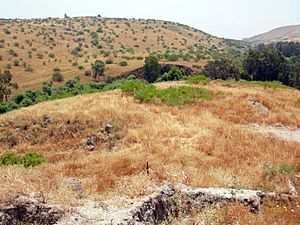
In 1179, Saladin's spies told him the Crusaders were planning a raid. He set a trap. The Crusaders, led by King Baldwin IV of Jerusalem, chased a small Muslim force. They became scattered, and Saladin's main army attacked. This led to a big victory for Saladin. Many Crusader knights were captured.
Baldwin then built a fortress at Jacob's Ford on the Jordan River. This fortress was a threat to Damascus. Saladin offered Baldwin a lot of money to stop building it, but Baldwin refused. Saladin then decided to destroy the fortress. He besieged it, and it fell on August 30, 1179.
In 1180, Saladin agreed to a truce with King Baldwin. This was because of droughts and bad harvests. The truce helped both sides.
Expanding the Empire
In 1180, Saladin met with Nur al-Din Muhammad, a leader from Mesopotamia. Saladin gave him many gifts to form an alliance. This helped Saladin gain influence in Mesopotamia.
Saladin returned to Cairo in 1181. He continued to manage the country's affairs. He also dealt with problems with the Bedouin tribes.
Campaign Against the Franks and War with the Zengids
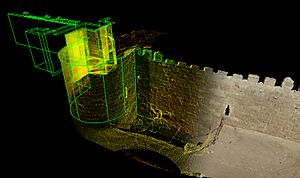
In 1181, the Zengid ruler Saif al-Din died. His brother, Izz al-Din, took over Mosul. Another Zengid leader, as-Salih, also died. Before he died, he made his officers promise loyalty to Izz al-Din. Izz al-Din then gave Aleppo to his brother, Imad al-Din Zangi. Saladin did not stop these changes, respecting his earlier treaty.
In May 1182, Saladin left Cairo for Syria. He never saw Egypt again. He knew Crusaders were waiting for him, so he took a desert route. He arrived in Damascus in June. His general, Farrukh-Shah, had already attacked the Galilee.
In July, Saladin led his army into Galilee. He attacked Beit She'an. He fought an unclear battle near Belvoir Castle. He then withdrew his army. In August, he besieged Beirut but soon left to deal with problems in Mesopotamia.
A leader from Harran invited Saladin to take over the Jazira region in northern Mesopotamia. Saladin agreed. The truce with the Zengids officially ended in September 1182. Saladin besieged Aleppo for three days to show the truce was over.
Saladin's forces, joined by allies, captured many cities in Jazira. They took Edessa, Saruj, Raqqa, and Nusaybin. Saladin impressed the people of Raqqa by canceling many taxes. He said, "the most miserable rulers are those whose purses are fat and their people thin."
Fight for Mosul
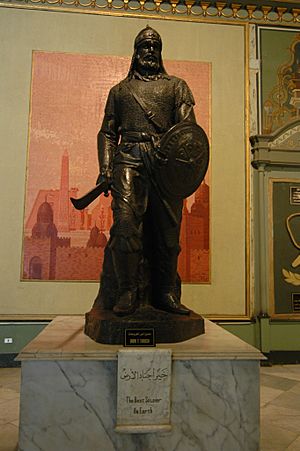
Saladin then moved towards Mosul. This was a big city, and he needed a good reason to attack it. The leaders of Mosul asked the caliph in Baghdad for help. Saladin arrived at Mosul on November 10, 1182. He laid siege to the city, but it was very strong.
After a long siege, Saladin decided to attack Sinjar, a city held by Izz al-Din's brother. Sinjar fell after 15 days on December 30. Saladin's soldiers looted the city. He then waited for a new army gathered by Izz al-Din. Saladin met this army in February 1183. But the enemy leaders asked for peace, and both sides returned home.
In March 1183, Saladin heard that Crusaders were attacking the Red Sea. Raynald de Châtillon had sent ships to raid towns. This was alarming because Muslims were not used to attacks there. Saladin sent his warships to the Red Sea. They destroyed most of the Crusader ships. The surviving Crusaders were captured and executed.
Saladin continued his war against Mosul. He captured Amid in April. He gave the city to Nur al-Din Muhammad, who then swore loyalty to Saladin. This weakened Izz al-Din's forces.
Taking Aleppo
Saladin then focused on Aleppo. His brother captured Tell Khalid, a city near Aleppo. Saladin arrived, and the city surrendered without a fight. On May 21, he camped outside Aleppo.
The leader of Aleppo, Zangi, did not resist for long. He was not popular and wanted to return to his old city, Sinjar. So, they made a deal. Zangi would give Aleppo to Saladin. In return, Saladin would give Zangi control of Sinjar, Nusaybin, and Raqqa. Zangi would rule these cities under Saladin.
On June 12, Aleppo officially became part of Saladin's empire. The people of Aleppo were surprised. Saladin made some changes to the city's religious leadership. He also allowed Zangi to take all his belongings from the citadel. Saladin believed that Aleppo was "the key to the lands" and "the eye of Syria."
After taking Aleppo, Saladin marched to Harim, a city near the Crusader-held Antioch. He offered the city's ruler, Surhak, other lands in exchange for Harim. But Surhak wanted more. His own soldiers forced him out, and Saladin took control of Harim. Saladin then made a truce with Bohemond, the Prince of Antioch.
Wars Against Crusaders
Crusader attacks often led to Saladin's responses. Raynald of Châtillon especially caused trouble. He attacked Muslim trade and pilgrimage routes on the Red Sea. He even threatened to attack the holy cities of Mecca and Medina.
On September 29, 1183, Saladin attacked Beit She'an. His forces sacked and burned the town. He then fought Crusader reinforcements. The main Crusader army, led by Guy of Lusignan, did not attack Saladin's main force. Saladin eventually withdrew his men.
Saladin then twice besieged Kerak, Raynald's fortress. He hoped to draw the Crusader army into a big battle. But the Crusaders avoided him and successfully defended the fortress.
In 1186, Raynald attacked a group of Muslim pilgrims on their way to the Hajj. He ignored the truce between Muslims and Crusaders. He also insulted the Islamic prophet, Muhammad. Saladin swore to personally execute Raynald for this.
On July 4, 1187, Saladin fought the combined Crusader forces at the Battle of Hattin. This was a huge victory for Saladin. The Crusader army was almost completely destroyed. This battle was a major turning point in the Crusades. Saladin captured Raynald and executed him himself. He also captured Guy of Lusignan. Guy feared he would be next, but Saladin spared his life. Saladin said, "It is not the wont of kings, to kill kings; but that man had transgressed all bounds."
Capture of Jerusalem
Saladin captured almost every Crusader city after Hattin. He wanted to take Jerusalem without fighting. He offered good terms to the people inside. But they refused to leave their holy city. They threatened to destroy it and kill all Muslim hostages if they were not given safe passage.
Saladin agreed to their terms. Jerusalem surrendered to his forces on October 2, 1187, after a siege. A low ransom was set for each person to leave the city. Saladin, against his treasurers' wishes, allowed many poor families to leave without paying. His brother, al-Adil, also freed a thousand people. Most of the foot soldiers were sold into slavery. After taking Jerusalem, Saladin allowed Jews to resettle in the city. He ordered some churches to be used as horse stables and church towers to be destroyed.
Tyre was the last major Crusader city not captured by Saladin. He chose to take Jerusalem first because of its importance to Islam. Tyre was defended by Conrad of Montferrat, who strengthened its defenses. Saladin besieged Tyre twice but could not capture it. In 1188, Saladin released Guy of Lusignan.
Saladin was also friendly with Queen Tamar of Georgia. She sent envoys to him to get back items from Georgian monasteries in Jerusalem. The Georgians were allowed to enter Jerusalem freely with their banners.
Third Crusade
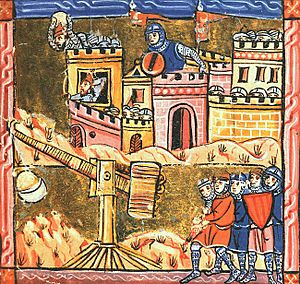
The fall of Jerusalem led to the Third Crusade (1189–1192). This crusade was partly paid for by a special "Saladin tithe." King Richard I of England led the siege of Acre. The Crusaders captured the city and executed almost 3,000 Muslim prisoners.
Saladin's armies fought King Richard's army at the Battle of Arsuf on September 7, 1191. Saladin's forces suffered heavy losses and had to retreat. After this battle, Richard took Jaffa and rebuilt its defenses. Saladin then destroyed the defenses of Ascalon. This was to stop the Crusaders from using this important city.
Richard and Saladin tried to make a truce. Richard even suggested that his sister marry Saladin's brother. Jerusalem could be their wedding gift. But Saladin refused when Richard insisted his brother become Christian.
In January 1192, Richard's army got close to Jerusalem but did not attack. Instead, Richard went south to Ascalon and rebuilt its defenses. In July 1192, Saladin tried to attack Jaffa. He almost captured it. But Richard arrived and defeated Saladin's army outside the city.
The Battle of Jaffa (1192) was the last big fight of the Third Crusade. Richard and Saladin finally agreed to a truce. Richard agreed to destroy Ascalon's defenses. Saladin agreed to let Crusaders control the coast from Tyre to Jaffa. Christians could also travel as unarmed pilgrims to Jerusalem. The peace would last for three years.
Death
Saladin died of a fever on March 4, 1193, in Damascus. This was not long after King Richard left. When he died, Saladin had very little money left. He had given most of his wealth to poor people. He was buried in a mausoleum in the garden outside the Umayyad Mosque in Damascus.
Centuries later, Emperor Wilhelm II of Germany gave a new marble coffin to the tomb. But Saladin's original wooden coffin was not replaced. So, the mausoleum now has two coffins. The original one covers Saladin's tomb, and the marble one is placed next to it.
Family
Saladin had many sons. Some of them became important rulers after him.
- al-Afḍal Nur al-Din Ali, emir of Damascus
- al-'Azīz Imad al-Din Abu al-Fath Uthman, sultan of Egypt
- al-Ẓāhir Ghiyath al-Din Abu Mansur Ghazi, emir of Aleppo
Not much is known about Saladin's wives. He married Ismat ad-Din Khatun in 1176, but they had no children.
Legacy and Recognition
In the Western World
Saladin was well-known in Europe during the Middle Ages. He was seen as a model king, known for his generosity. Writers like Walther von der Vogelweide and Jans der Enikel praised him. In The Divine Comedy, Dante even placed him among the good non-Christians. He also appears in Boccaccio's The Decameron.
In modern times, Saladin is often shown in a positive light. Lessing's play Nathan the Wise features him. Sir Walter Scott's novel The Talisman (1825) greatly influenced how people saw Saladin. Scott showed him as a kind and modern leader.
Despite the wars, Christian leaders respected Saladin. King Richard I called him a great prince. Saladin, in turn, said Richard was a very honorable Christian lord. They exchanged gifts as a sign of respect but never met in person. Saladin was also known for his fairness. He helped a Frankish woman get her stolen baby back.
In the Muslim World
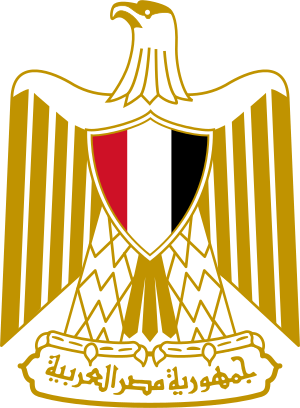
Saladin is a very important figure in Islamic, Arab, Turkish, and Kurdish cultures. He is often called the most famous Kurd in history. Many see him as the person who brought back the spirit of early Islamic leaders.
In 1898, German Emperor Wilhelm II visited Saladin's tomb. This visit, along with growing anti-imperialist feelings, helped make Saladin a symbol of resistance against the West in the Arab world. Before this, his fame had faded a bit.
Modern Arab countries honor Saladin in many ways. A region in Iraq, Saladin Governorate, is named after him. Salahaddin University in Erbil, Kurdistan, is also named for him.
Few buildings from Saladin's time still stand. He strengthened the Cairo Citadel (1175–1183). This helped make Cairo more secure.
Even though his family's rule, the Ayyubid dynasty, lasted only 57 years after him, Saladin's legacy continues. With the rise of Arab nationalism in the 20th century, Saladin became a symbol of Arab unity and leadership. His recapture of Palestine from the Crusaders inspired modern Arab opposition to Zionism. The Eagle of Saladin is now a symbol for many Arab states, including Egypt, Iraq, and Palestine.
However, among some Egyptian Shia Muslims, Saladin is called "Kharab al-Din." This means "destroyer of religion," because he ended the Shia Fatimid rule in Egypt.
Cultural Depictions of Saladin
Novels
- The Talisman by Walter Scott (1825): This novel is set during the Third Crusade. It focuses on the relationship between King Richard I of England and Saladin.
- The Book of Saladin (1998): A novel based on Saladin's life.
Film, Television, and Animation
- Ghazi Salahuddin (1939): An Indian film, the first to show Saladin.
- Saladin the Victorious (1963): An Egyptian war drama film. Ahmed Mazhar played Saladin.
- Doctor Who (1965): Saladin appears in the episode "The Crusade".
- Kingdom of Heaven (2005): Saladin's role was played by Ghassan Massoud.
- King Richard and the Crusaders (1954): Saladin's role was played by Rex Harrison.
- Salah Al-deen Al-Ayyobi (2001): A TV series about Saladin's life.
- Saladin: The Animated Series: An animated project inspired by Saladin.
Video Games
- Saladin appears as a leader in the "Civilization" video game series.
- Saladin is a playable character in the game "Rise of Kingdoms".
Visual Art
- The Statue of Saladin is a large bronze statue of Saladin. It is located in front of the Citadel of Damascus in Syria.
Images for kids
-
Dirham coin depicting Saladin (c. 1189)
-
Saladin's battles in Egypt
-
19th-century depiction of a victorious Saladin, by Gustave Doré
-
Saladin ended his siege of the Ismaili ("Assassins") fortress of Masyaf, which was commanded by Rashid ad-Din Sinan, under uncertain circumstances in August 1176.
-
Saladin assured the protection of caravan routes that allowed travel to distant lands.
-
The battlefield at Jacob's Ford, looking from the west bank to the east bank of the River Jordan
-
Isometric laser scan data image of the Bab al-Barqiyya Gate in the 12th century Ayyubid Wall. This fortified gate was constructed with interlocking volumes that surrounded the entrant in such a way as to provide greater security and control than typical city wall gates.
-
Sculpture of Saladin in the Egyptian Military museum in Cairo
-
Saladin and Guy of Lusignan after the Battle of Hattin
-
The elite garrison of Saladin's armies during the Siege of Acre
-
Saladin's tomb, near the northwest corner of the Umayyad Mosque, Damascus, Syria.
-
The Eagle of Saladin in the Egyptian coat of arms
See also
 In Spanish: Saladino para niños
In Spanish: Saladino para niños
- Battles of Saladin
- List of Ayyubid rulers
- List of Kurdish dynasties and countries
- Sharaf Khan Bidlisi
- Kingdom of Heaven
- The Crusades
- King Richard and the Crusaders
- Saladin: The Animated Series
- Saladin the Victorious
- Salah al-Din (TV series)
- Arn – The Knight Templar


